Pre-Positioning Facility Location and Resource Allocation in Humanitarian Relief Operations Considering Deprivation Costs
Abstract
1. Introduction
- A scenario-based stochastic programming model was built. The modeling framework considers the possibility of frequent disaster scenarios and involves a variety of decisions at both strategic (e.g., facility location, material prepositioning) and operational levels across all possible disaster scenarios (e.g., service allocation).
- The interrelationship between the economic (e.g., facility setup cost, material inventory cost, transportation cost) and social (e.g., victims’ deprivation cost) considerations was explored in the same optimization modeling structure. Three types of typical deprivation cost functions were applied to describe the loss accumulation patterns of the victims and examine the sensitivity of different deprivation cost measurements.
- Management insights: The numerical results show the significance of the deprivation cost is nonnegligible when making optimal decisions. To reduce the loss of the victims in the humanitarian supply system, emergency storage centers tend to be built locally, and most of the service allocation relationships present simple one-to-one or one-to-two modes to centralize the material supply. Different forms of the deprivation cost function do not have a significant impact on the final optimal solutions, but if the periodical transportation pattern is changed, the optimal solutions will change dramatically. The sensitivity analysis results indicate that when the link travel time of the disaster area increases or the decision-maker puts more focus on the victims’ benefits, more locations and more contracted service modes can be observed. These results might be helpful to better understand the occurrence and progress of humanitarian logistics activities and provide useful references for emergency managers to make decisions.
2. Literature Review
3. Problem Description and Model Formulation
3.1. Notations and Problem Description
3.2. Deprivation Costs in Humanitarian Relief
3.3. More Considerations on the Deprivation Cost
- (1)
- Exponential growth only and no hysteretic effect
- (2)
- Quadratic growth with hysteretic effect
4. Numerical Study
4.1. Basic Parameter Settings
4.2. Numerical Experiments When Considering Demand Uncertainty
4.3. Numerical Results of Different Deprivation Cost Functions
4.4. Numerical Results of Different Travel Modes
4.5. Sensitivity Analysis
- (1)
- Transportation time
- (2)
- Weighting coefficient
5. Conclusions
Author Contributions
Funding
Institutional Review Board Statement
Informed Consent Statement
Data Availability Statement
Conflicts of Interest
Appendix A
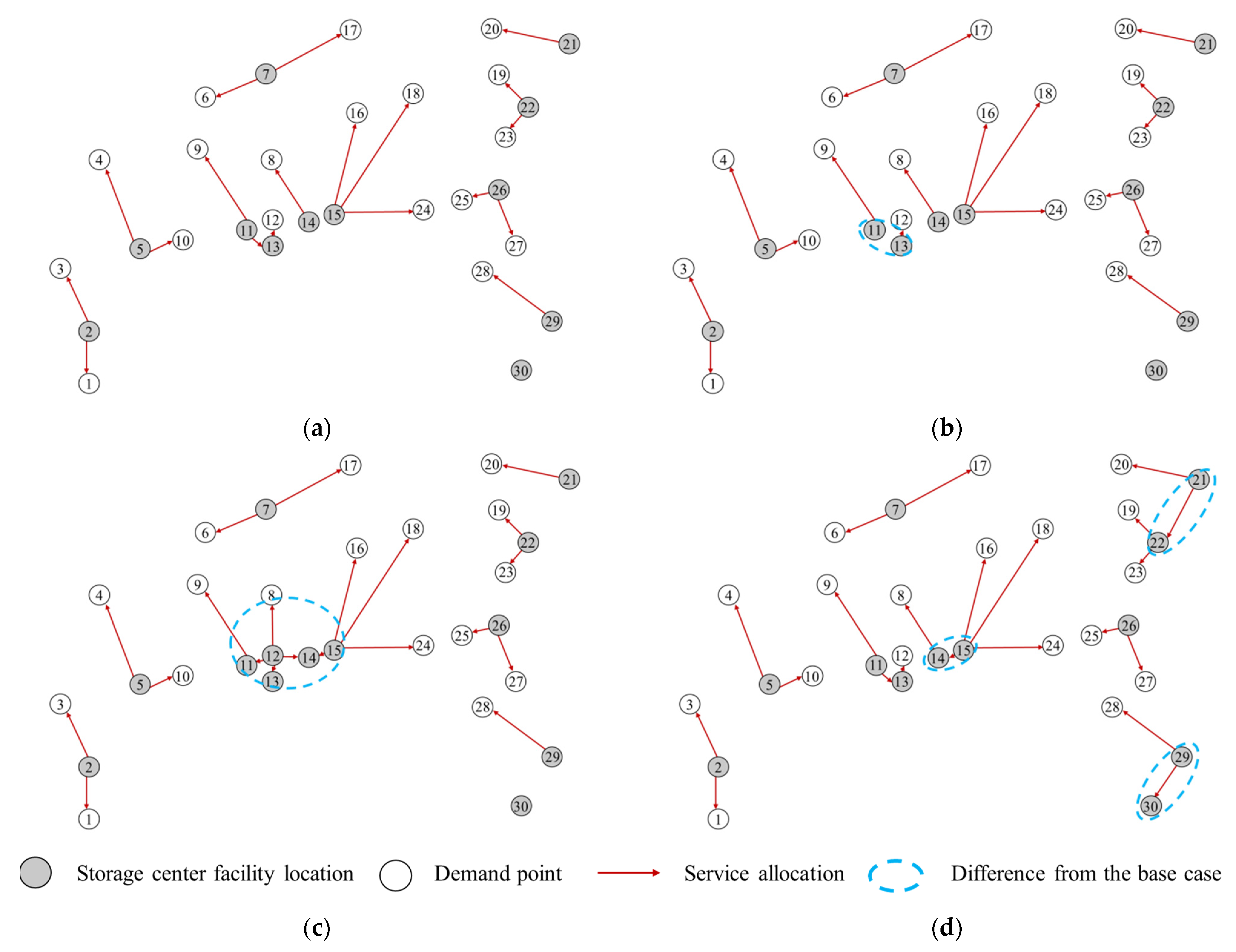
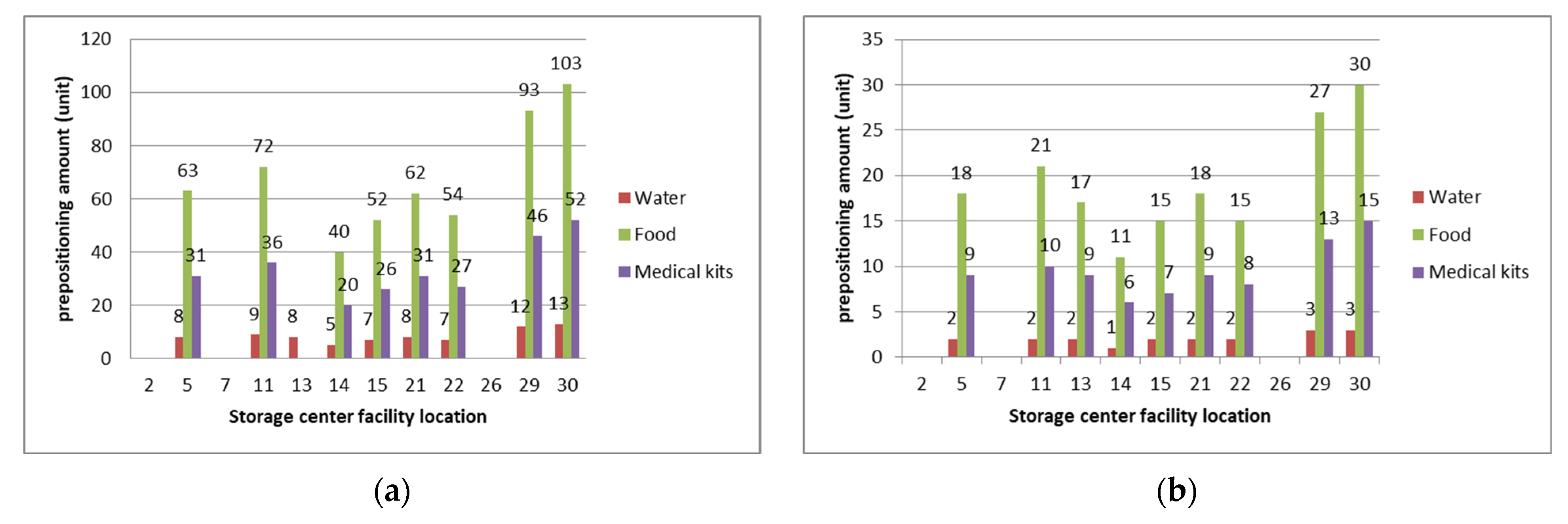
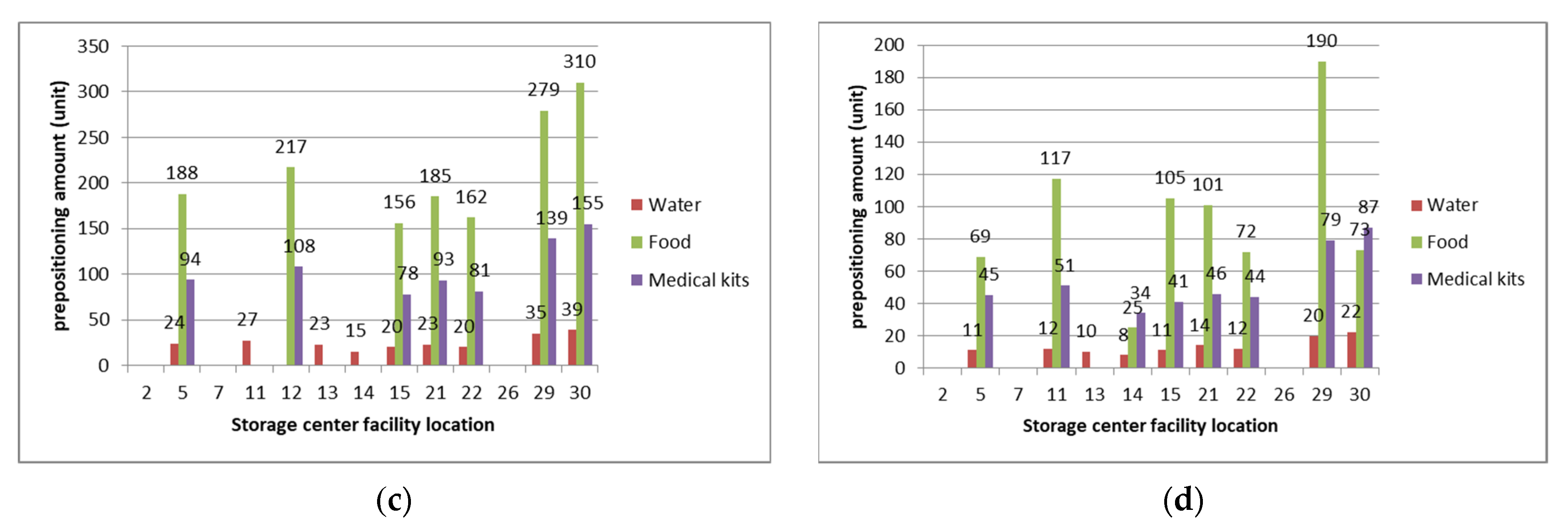
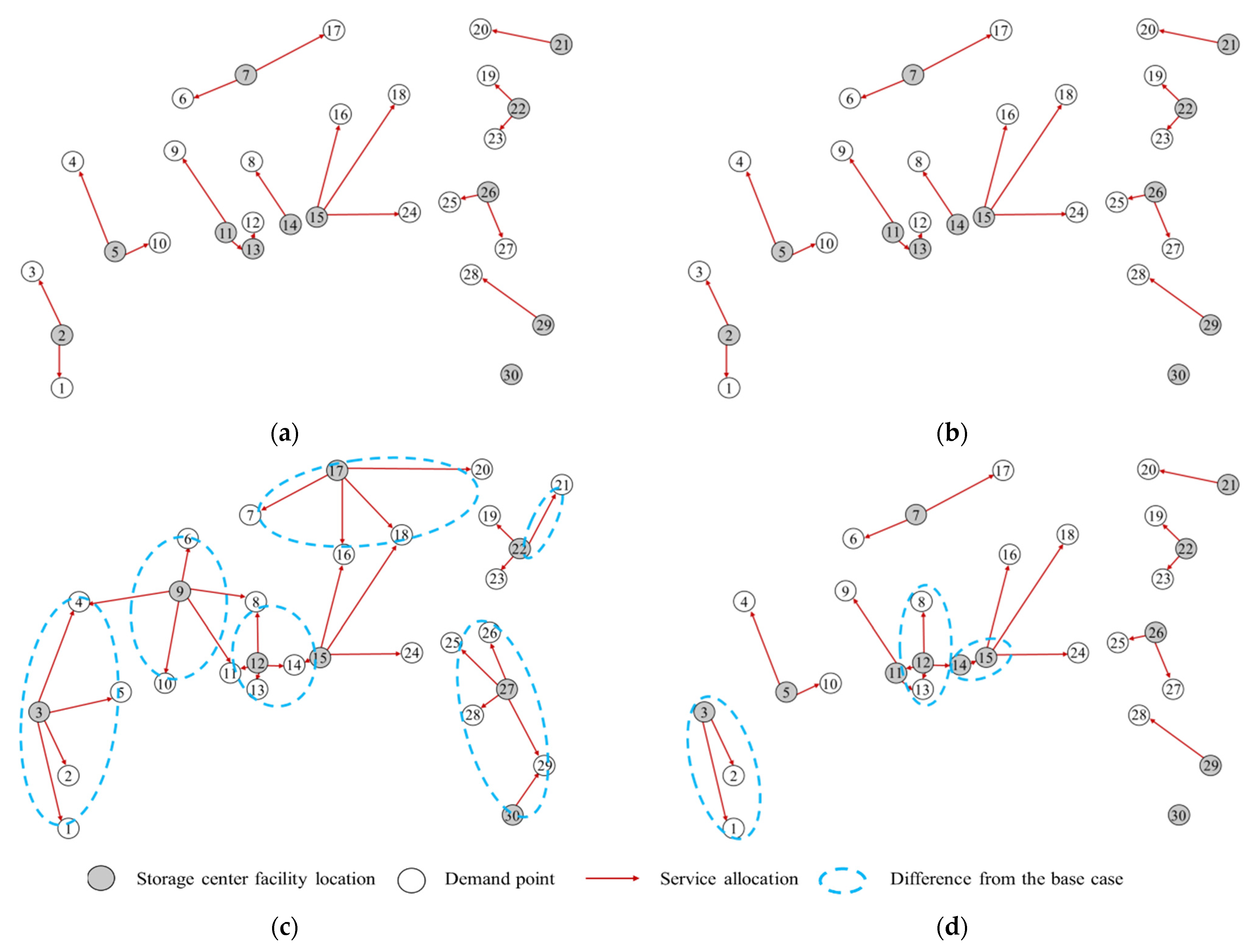
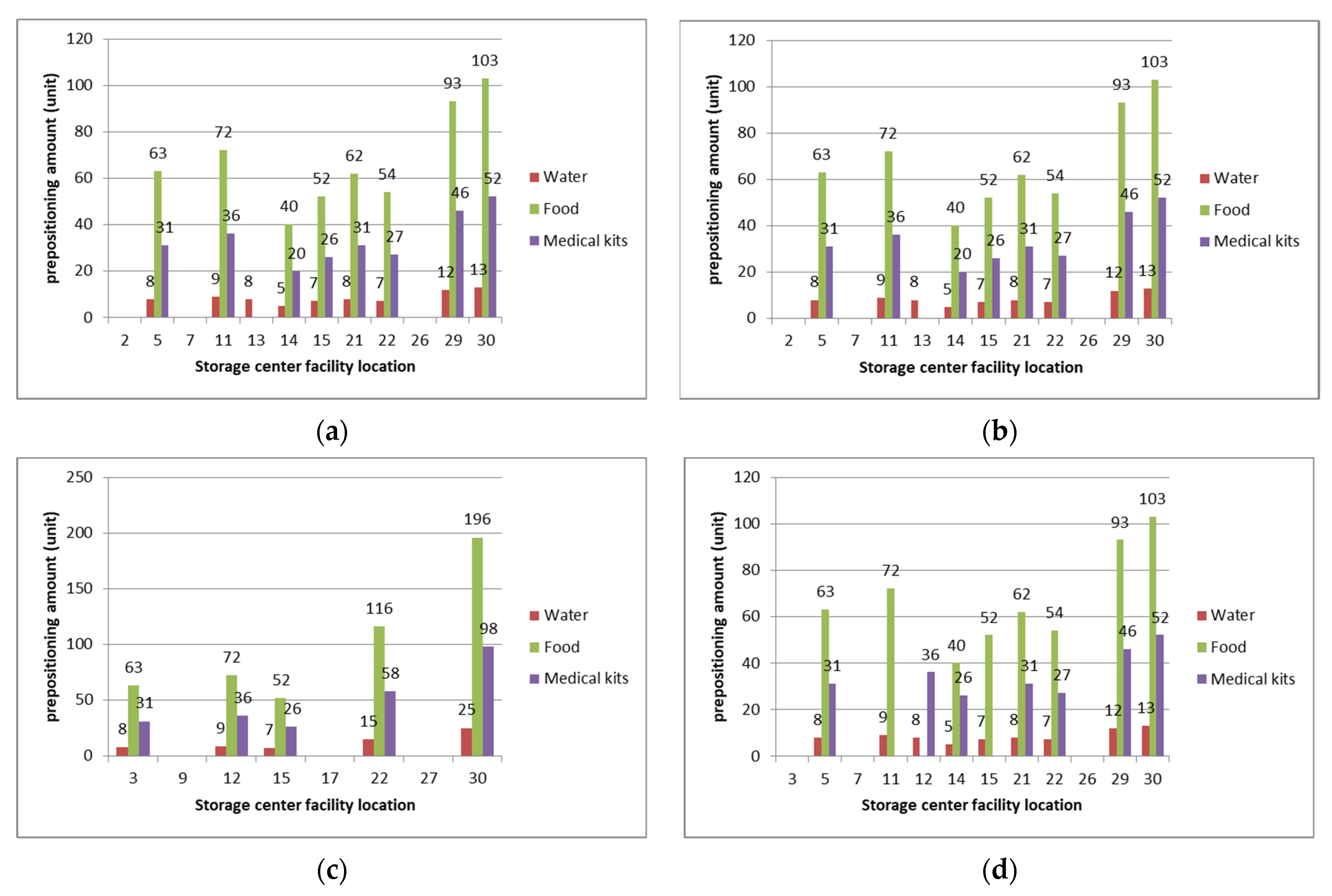

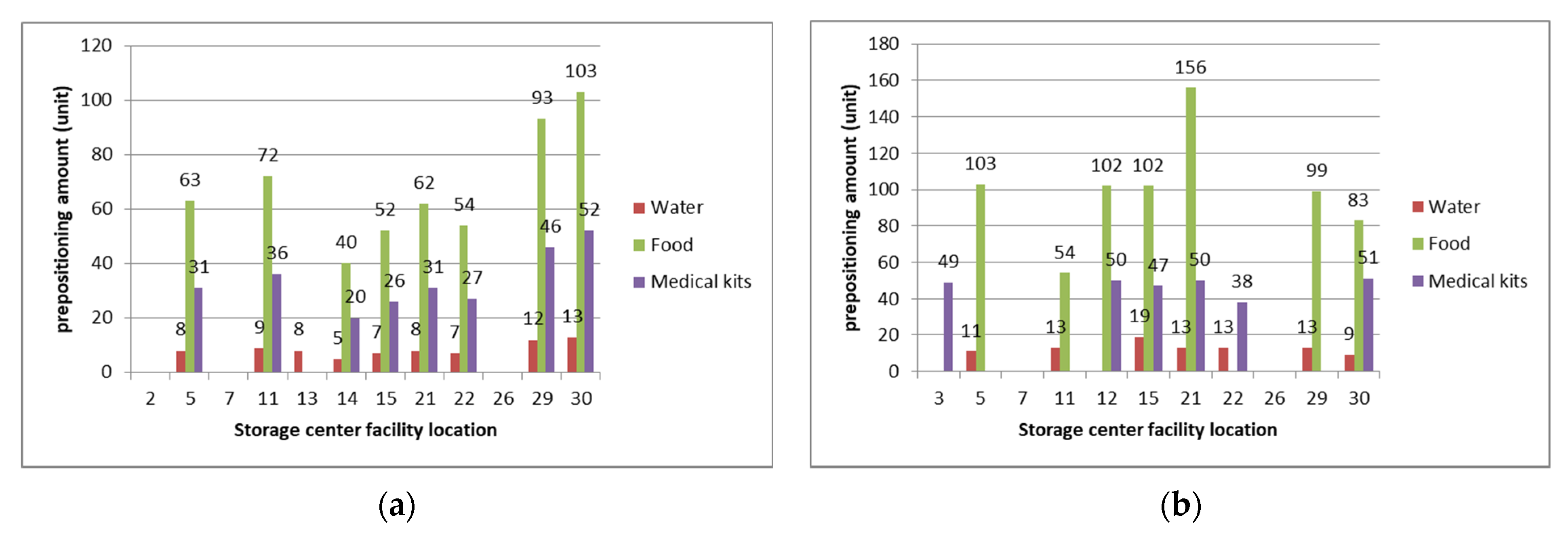
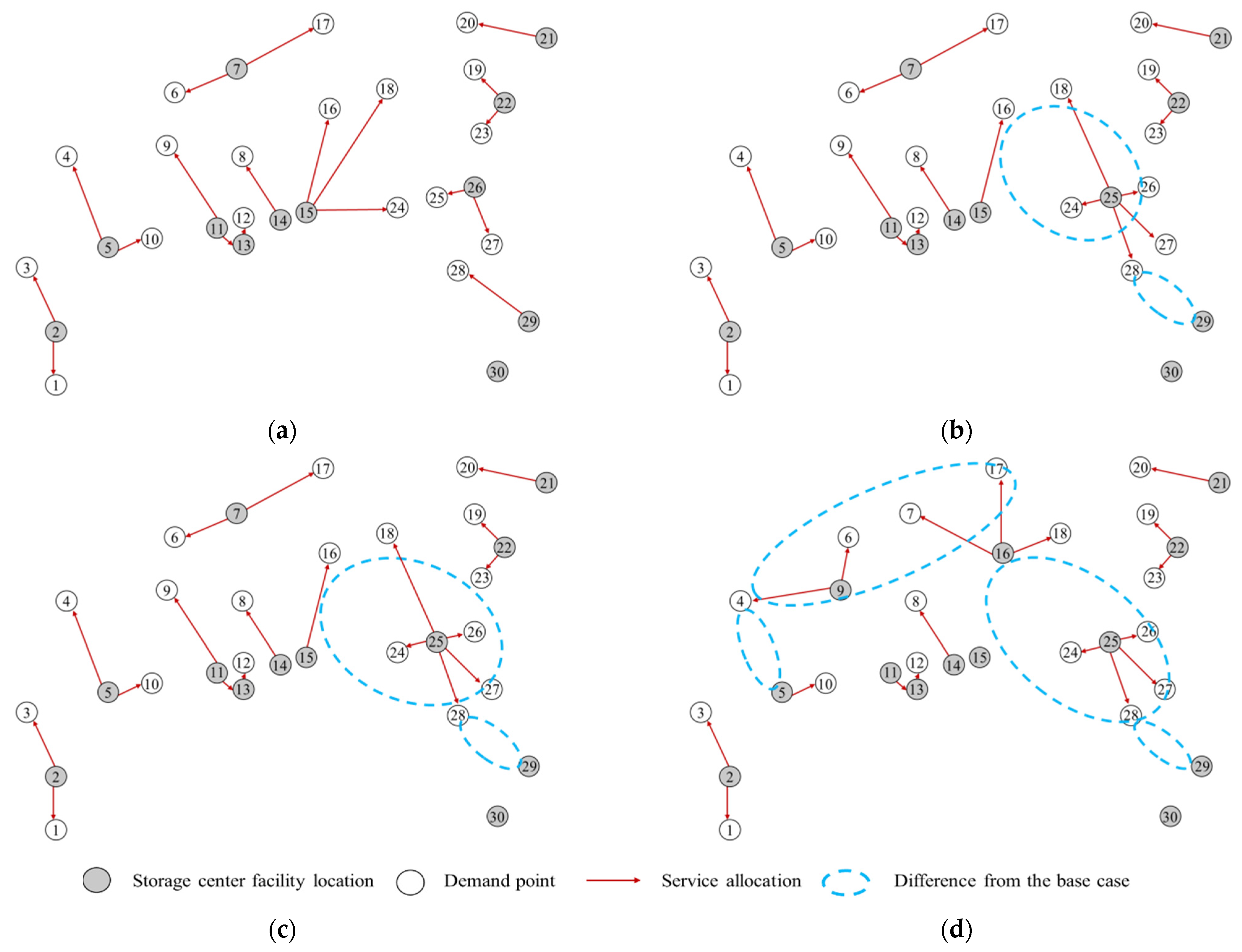
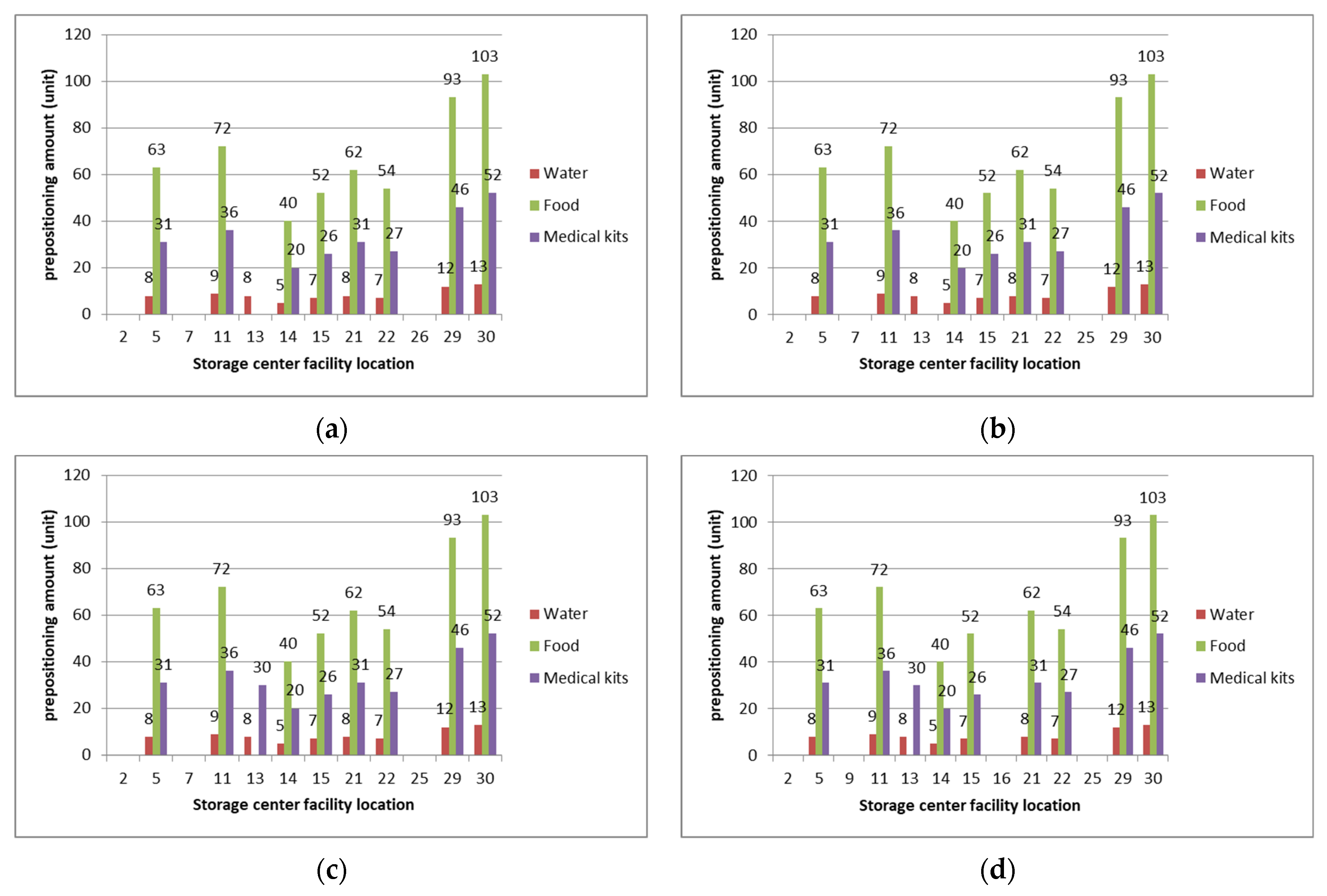

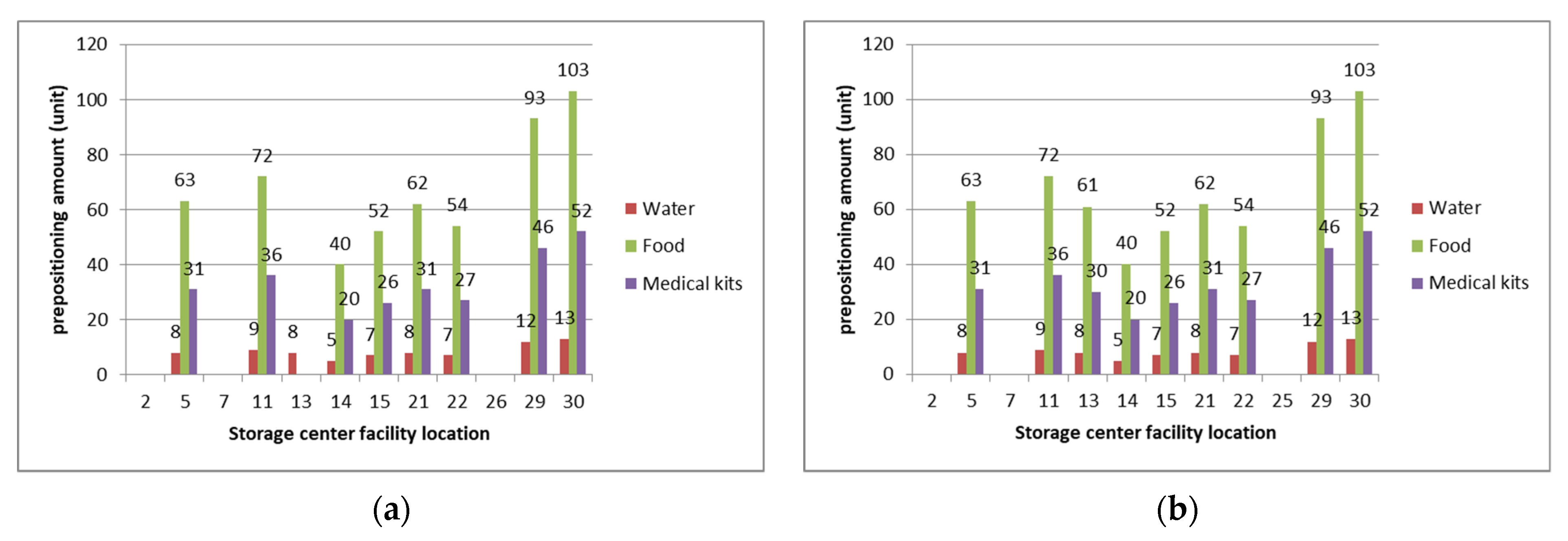
| Case | Location | |||||
|---|---|---|---|---|---|---|
| Minimum demand | 2,5,7,11,13,14,15,21,22,26,29,30 | 1.99 | 1.16 | 363 | 2.60 | 5.75 |
| Average demand (base case) | 2,5,7,11,13,14,15,21,22,26,29,30 | 1.99 | 3.69 | 1544 | 2.76 | 8.44 |
| Maximum demand | 2,5,7,11,12,13,14,15,21,22,26,29,30 | 2.19 | 10.1 | 7367 | 3.52 | 15.81 |
| Stochastic demand | 2,5,7,11,13,14,15,21,22,26,29,30 | 1.99 | 5.84 | 1736 | 2.79 | 10.62 |
| Case | Location | |||||
|---|---|---|---|---|---|---|
| Benchmark case (exponential growth with hysteretic effect) | 2,5,7,11,13,14,15,21,22,26,29,30 | 1.99 | 3.69 | 1544 | 2.76 | 8.44 |
| Case I-1 (exponential growth only and no hysteretic effect, ) | 2,5,7,11,13,14,15,21,22,26,29,30 | 1.99 | 3.69 | 1544 | 2.71 | 8.39 |
| Case I-2 (exponential growth only and no hysteretic effect,) | 3,9,12,15,17,22,27,30 | 1.36 | 3.27 | 11,628 | 40.8 | 45.43 |
| Case II (quadratic growth with linear hysteretic effect) | 3,5,7,11,12,14,15,21,22,26,29,30 | 2.03 | 3.36 | 2368 | 0.41 | 5.80 |
| Cases | Location | |||||
|---|---|---|---|---|---|---|
| Vehicle transportation | 2,5,7,11,13,14,15,21,22,26,29,30 | 1.99 | 5.27 | 1804 | 2.78 | 10.04 |
| Aircraft transportation | 3,5,7,11,12,15,21,22,26,29,30 | 1.86 | 3.78 | 2.99 | 0.34 | 8.97 |
| Case | Location | Travel Cost ($) | ||||
|---|---|---|---|---|---|---|
(Base case) | 2,5,7,11,13,14,15,21,22,26,29,30 | 1.99 | 3.69 | 1544 | 2.76 | 8.44 |
| 2,5,7,11,13,14,15,21,22,26,29,30 | 1.99 | 3.69 | 1544 | 3.40 | 9.08 | |
| 2,5,7,11,13,14,15,21,22,25,29,30 | 2.03 | 3.69 | 1544 | 4.38 | 10.10 | |
| 2,5,7,11,13,14,15,21,22,25,29,30 | 2.03 | 4.05 | 1350 | 5.03 | 11.11 | |
| 2,5,9,11,13,14,15,16,21,22,25,29,30 | 2.21 | 4.05 | 1350 | 5.58 | 11.84 |
| Cases | Location | |||||
|---|---|---|---|---|---|---|
| 2,5,7,11,13,14,15,21,22,25,29,30 | 2.03 | 4.06 | 1283 | 13.00 | 19.09 | |
| 2,5,7,11,13,14,15,21,22,26,29,30 | 1.99 | 3.69 | 1544 | 5.53 | 11.21 | |
(Base case) | 2,5,7,11,13,14,15,21,22,26,29,30 | 1.99 | 3.69 | 1544 | 2.76 | 8.44 |
| 5,12,19,30 | 0.69 | 1.89 | 0.17 | 0 | 2.75 |
References
- UNISDR. Hyogo Framework for Action 2005–2015 Building the Resilience of Nations and Communities to Disasters. In Proceedings of the World Conference on Disaster Reduction, Hyogo, Japan, 18–22 January 2005. [Google Scholar]
- Ni, W.; Shu, J.; Song, M. Location and Emergency Inventory Pre-Positioning for Disaster Response Operations: Min-Max Ro-bust Model and a Case Study of Yushu Earthquake. Prod. Oper. Manag. 2018, 27, 160–183. [Google Scholar] [CrossRef]
- Djimesah, I.E.; Okine, A.N.D.; Mireku, K.K. Influential factors in creating warning systems towards flood disaster management in Ghana: An analysis of 2007 Northern flood. Int. J. Disaster Risk Reduct. 2018, 28, 318–326. [Google Scholar] [CrossRef]
- Thomas, A. Humanitarian Logistics Enabling Disaster Response; Fritz Institute: San Francisco, CA, USA, 2004. [Google Scholar]
- Pérez-Rodríguez, N.; Holguín-Veras, J. Inventory-Allocation Distribution Models for Postdisaster Humanitarian Logistics with Explicit Consideration of Deprivation Costs. Transp. Sci. 2016, 50, 1261–1285. [Google Scholar] [CrossRef]
- Holguín-Veras, J.; Jaller, M.; Van Wassenhove, L.N.; Pérez, N.; Wachtendorf, T. On the unique features of post-disaster humani-tarian logistics. J. Oper. Manag. 2012, 30, 494–506. [Google Scholar] [CrossRef]
- McLachlin, R.; Larson, P.D.; Khan, S. Not-for-profit Supply Chains in Interrupted Environments The Case of a Faith-based Humanitarian Relief Organisation. Manag. Res. News 2009, 32, 1050–1064. [Google Scholar] [CrossRef]
- Holguín-Veras, J.; Jaller, M. Immediate Resource Requirements after Hurricane Katrina. Nat. Hazards Rev. 2012, 13, 117–131. [Google Scholar] [CrossRef]
- Rawls, C.G.; Turnquist, M.A. Pre-positioning of emergency supplies for disaster response. Transp. Res. Part B Methodol. 2010, 44, 521–534. [Google Scholar] [CrossRef]
- Besiou, M.; Stapleton, O.; Van Wassenhove, L.N. System dynamics for humanitarian operations. J. Humanit. Logist. Supply Chain Manag. 2011, 1, 78–103. [Google Scholar] [CrossRef]
- Khayal, D.; Pradhananga, R.; Pokharel, S.; Mutlu, F. A model for planning locations of temporary distribution facilities for emergency response. Socio-Econ. Plan. Sci. 2015, 52, 22–30. [Google Scholar] [CrossRef]
- Moreno, A.; Alem, D.; Ferreira, D.; Clark, A. An effective two-stage stochastic multi-trip location-transportation model with social concerns in relief supply chains. Eur. J. Oper. Res. 2018, 269, 1050–1071. [Google Scholar] [CrossRef]
- Khorram-Manesh, A.; Phattharapornjaroen, P.; Mortelmans, L.J.; Goniewicz, K.; Verheul, M.; Sörensen, J.L.; Pereira, I.; Ricklin, M.; Faccincani, R.; Dark, P.M.; et al. Current Perspectives and Concerns Facing Hospital Evacuation: The Results of a Pilot Study and Literature Review. Disaster Med. Public Health Prep. 2021, 1–9. [Google Scholar] [CrossRef]
- Holguín-Veras, J.; Pérez, N.; Jaller, M.; Van Wassenhove, L.N.; Aros-Vera, F. On the appropriate objective function for post-disaster humanitarian logistics models. J. Oper. Manag. 2013, 31, 262–280. [Google Scholar] [CrossRef]
- Holguín-Veras, J.; Amaya-Leal, J.; Cantillo, V.; Van Wassenhove, L.N.; Aros-Vera, F.; Jaller, M. Econometric estimation of depriva-tion cost functions: A contingent valuation experiment. J. Oper. Manag. 2016, 45, 44–56. [Google Scholar] [CrossRef]
- Cantillo, V.; Serrano, I.; Macea, L.F.; Holguín-Veras, J. Discrete choice approach for assessing deprivation cost in humanitarian relief operations. Socio-Econ. Plan. Sci. 2018, 63, 33–46. [Google Scholar] [CrossRef]
- Cotes, N.; Cantillo, V. Including deprivation costs in facility location models for humanitarian relief logistics. Socio-Econ. Plan. Sci. 2019, 65, 89–100. [Google Scholar] [CrossRef]
- Zhu, L.; Gong, Y.; Xu, Y.; Gu, J. Emergency relief routing models for injured victims considering equity and priority. Ann. Oper. Res. 2018, 283, 1573–1606. [Google Scholar] [CrossRef]
- Shao, J.; Wang, X.; Liang, C.; Holguín-Veras, J. Research progress on deprivation costs in humanitarian logistics. Int. J. Disaster Risk Reduct. 2020, 42, 101343. [Google Scholar] [CrossRef]
- An, S.; Cui, N.; Li, X.; Ouyang, Y. Location planning for transit-based evacuation under the risk of service disruptions. Transp. Res. Part B Methodol. 2013, 54, 1–16. [Google Scholar] [CrossRef]
- Yu, L.; Zhang, C.; Yang, H.; Miao, L. Novel methods for resource allocation in humanitarian logistics considering human suf-fering. Comput. Ind. Eng. 2018, 119, 1–20. [Google Scholar] [CrossRef]
- MacPherson, R.I.; Burkle, F.M. Humanitarian Aid Workers: The Forgotten First Responders. Prehospital Disaster Med. 2021, 36, 111–114. [Google Scholar] [CrossRef] [PubMed]
- Sheu, J.-B. An emergency logistics distribution approach for quick response to urgent relief demand in disasters. Transp. Res. Part E Logist. Transp. Rev. 2007, 43, 687–709. [Google Scholar] [CrossRef]
- Oliva, S.; Lazzeretti, L. Measuring the economic resilience of natural disasters: An analysis of major earthquakes in Japan. City Cult. Soc. 2018, 15, 53–59. [Google Scholar] [CrossRef]
- IFIS. The International Federation’s Global Agenda (2006–2010); International Federation of Red Cross and Red Crescent Societies: Paris, France, 2006. [Google Scholar]
- Barmania, S. Typhoon Haiyan recovery: Progress and challenges. Lancet 2014, 383, 1197–1199. [Google Scholar] [CrossRef]
- IFRC. World Disasters Report, 2015: Focus on Local Actors, the Key to Humanitarian Effectiveness; International Federation of Red Cross and Red Crescent Societies: Paris, France, 2016. [Google Scholar]
- Rattanakanlaya, K.; Sukonthasarn, A.; Wangsrikhun, S.; Chanprasit, C. A survey of flood disaster preparedness among hospitals in the central region of Thailand. Australas. Emerg. Nurs. J. 2016, 19, 191–197. [Google Scholar] [CrossRef] [PubMed]
- Gutjahr, W.J.; Fischer, S. Equity and deprivation costs in humanitarian logistics. Eur. J. Oper. Res. 2018, 270, 185–197. [Google Scholar] [CrossRef]
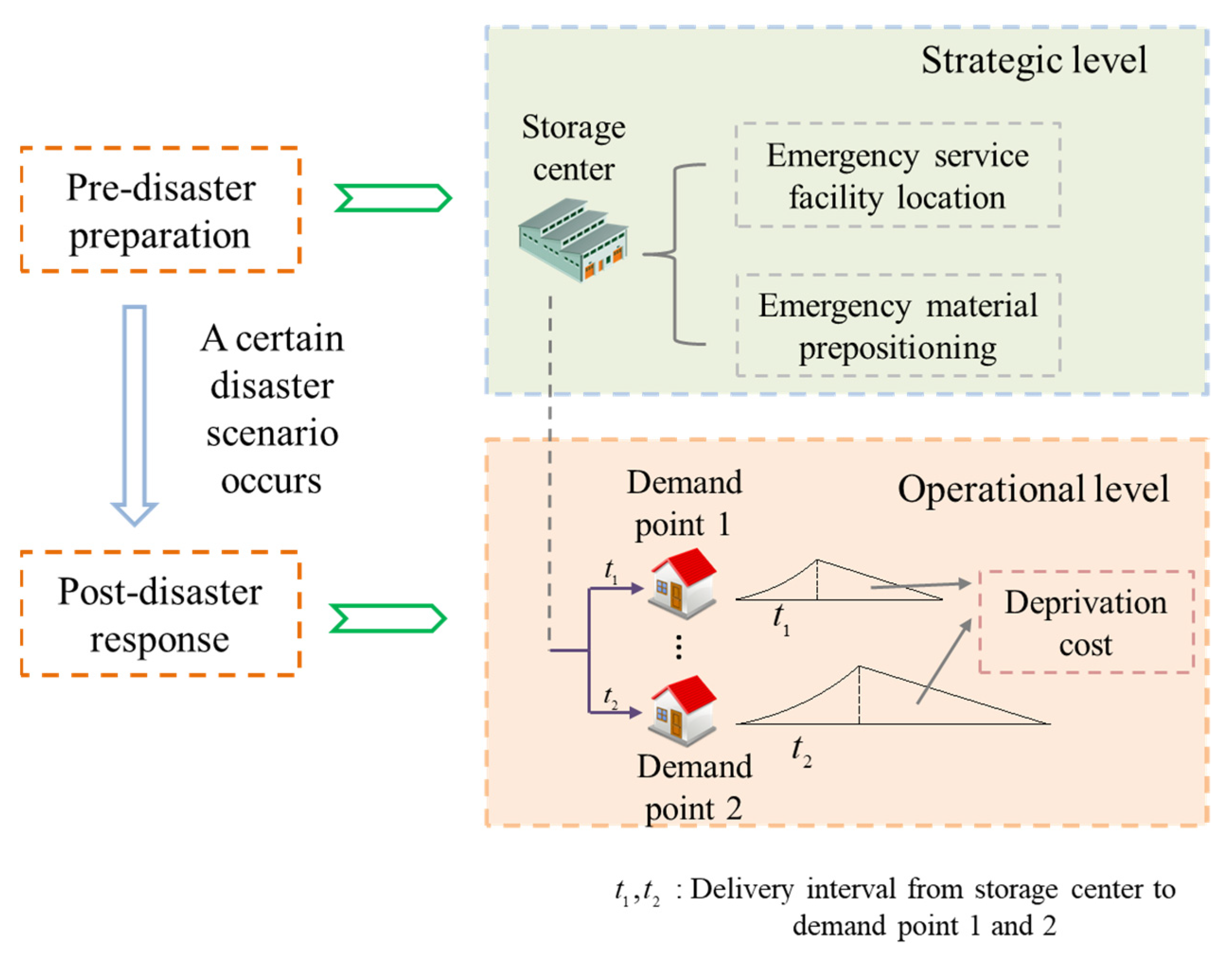
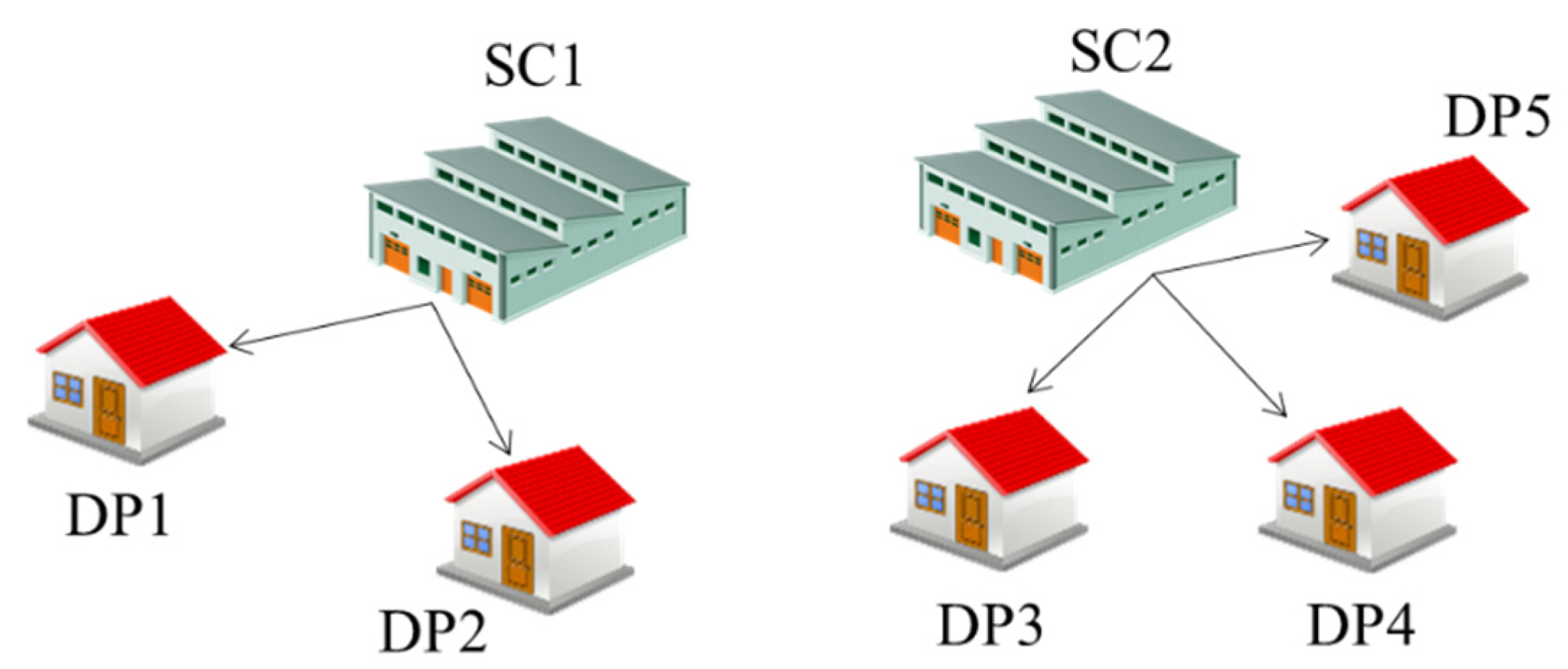

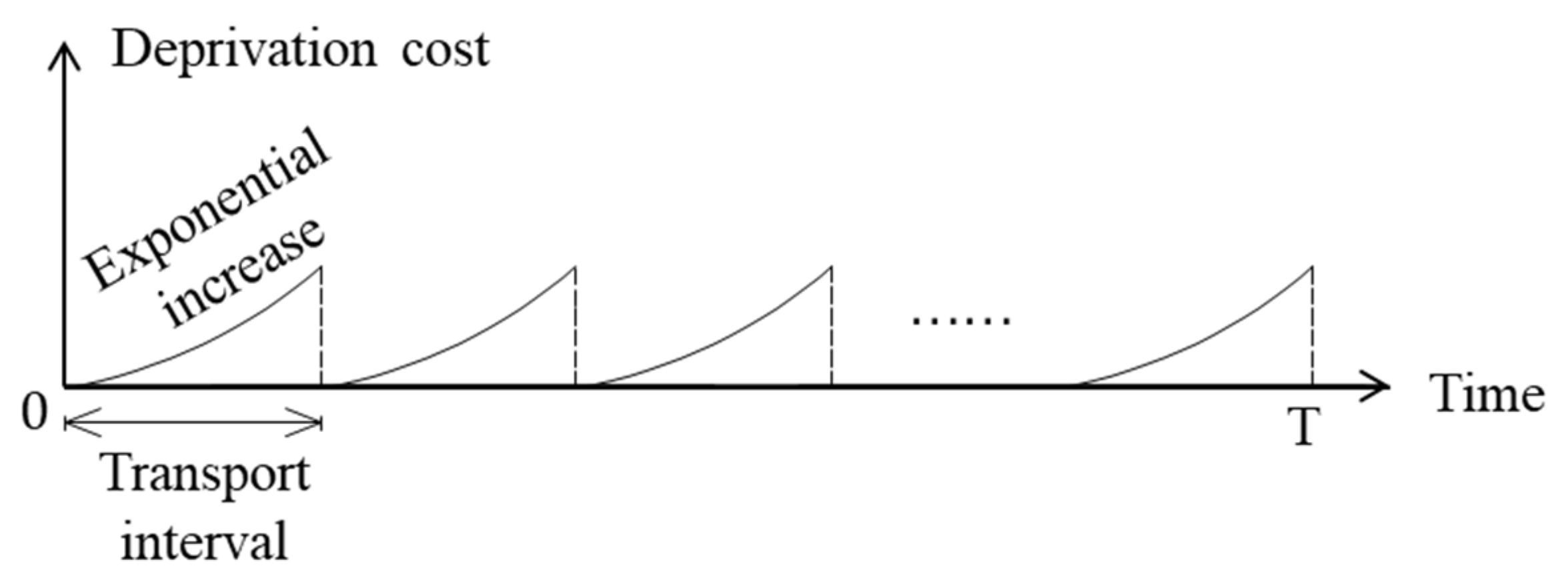

| Commodities | |||
|---|---|---|---|
| Water (1000 gals) | 144.6 | 0.00044 | 0.45 |
| Food (1000 MREs) | 83.33 | 0.003 | 0.112 |
| Medical kits (1000) | 1160 | 0.001 | 0.66 |
| Hurricane | Affected Node | Population |
|---|---|---|
| 1 | 5 | 6132 |
| 2 | 14 | 3929 |
| 3 | 22 | 5274 |
| 4 | 22 | 5274 |
| 5 | 11 | 7081 |
| 29 | 9100 | |
| 6 | 15 | 5105 |
| 7 | 21 | 6052 |
| 8 | 11 | 7081 |
| 9 | 13 | 5936 |
| 29 | 9100 | |
| 10 | 21 | 6052 |
| 11 | 21 | 6052 |
| 12 | 15 | 5105 |
| 13 | 29 | 9100 |
| 14 | 14 | 3929 |
| 30 | 10,120 | |
| 15 | 22 | 5274 |
| Commodities | ||
|---|---|---|
| Water | 0.1172 | 1.5031 |
| Food | 0.1 | 1.2 |
| Medical kits | 0.67 | 2 |
Publisher’s Note: MDPI stays neutral with regard to jurisdictional claims in published maps and institutional affiliations. |
© 2021 by the authors. Licensee MDPI, Basel, Switzerland. This article is an open access article distributed under the terms and conditions of the Creative Commons Attribution (CC BY) license (https://creativecommons.org/licenses/by/4.0/).
Share and Cite
Zhang, L.; Cui, N. Pre-Positioning Facility Location and Resource Allocation in Humanitarian Relief Operations Considering Deprivation Costs. Sustainability 2021, 13, 4141. https://doi.org/10.3390/su13084141
Zhang L, Cui N. Pre-Positioning Facility Location and Resource Allocation in Humanitarian Relief Operations Considering Deprivation Costs. Sustainability. 2021; 13(8):4141. https://doi.org/10.3390/su13084141
Chicago/Turabian StyleZhang, Linlin, and Na Cui. 2021. "Pre-Positioning Facility Location and Resource Allocation in Humanitarian Relief Operations Considering Deprivation Costs" Sustainability 13, no. 8: 4141. https://doi.org/10.3390/su13084141
APA StyleZhang, L., & Cui, N. (2021). Pre-Positioning Facility Location and Resource Allocation in Humanitarian Relief Operations Considering Deprivation Costs. Sustainability, 13(8), 4141. https://doi.org/10.3390/su13084141





